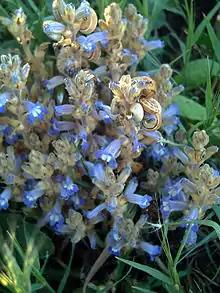Orobanche ramosa
Orobanche ramosa is a species of broomrape known by the common names hemp broomrape[1][2] and branched broomrape. It is native to Eurasia and North Africa, but it is known in many other places as an introduced species and sometimes a noxious weed.[3]
| Orobanche ramosa | |
|---|---|
 | |
| Scientific classification | |
| Kingdom: | Plantae |
| Clade: | Tracheophytes |
| Clade: | Angiosperms |
| Clade: | Eudicots |
| Clade: | Asterids |
| Order: | Lamiales |
| Family: | Orobanchaceae |
| Genus: | Orobanche |
| Species: | O. ramosa |
| Binomial name | |
| Orobanche ramosa | |
| Synonyms | |
|
Phelipanche ramosa (L.) Pomel | |
It is a pest in agricultural fields, infesting crops including tobacco,[4] potato,[5] and tomato.[6]
The plant produces many slender, erect stems from a thick root. The yellowish stems grow 10 to 60 centimeters tall and are coated in glandular hairs. The broomrape is parasitic on other plants, draining nutrients from their roots, and it lacks leaves and chlorophyll. The inflorescence bears several flowers, each in a yellowish calyx of sepals and with a tubular white and blue to purple corolla.
References
- "BSBI List 2007". Botanical Society of Britain and Ireland. Archived from the original (xls) on 2015-01-25. Retrieved 2014-10-17.
- "Orobanche ramosa". Natural Resources Conservation Service PLANTS Database. USDA. Retrieved 30 January 2016.
- Joel, D. M. (2009). "The new nomenclature of Orobanche and Phelipanche". Weed Research. 49: 6–7. doi:10.1111/j.1365-3180.2009.00748.x.
- Karkanis, A.; et al. (2007). "Tobacco (Nicotiana tabaccum) infection by branched broomrape (Phelipanche ramosa) as influenced by irrigation system and fertilization, under East Mediterranean conditions". Journal of Agronomy. 6 (3): 397–402.
- Haidar, M. A.; et al. (2005). "Selective control of Orobanche ramosa in potato with rimsulfuron and sub-lethal doses of glyphosate". Crop Protection. 24 (8): 743–47. doi:10.1016/j.cropro.2005.01.005.
- Mauromicale, G.; et al. (2008). "Effect of branched broomrape (Orobanche ramosa) infection on the growth and photosynthesis of tomato". Weed Science. 56 (4): 574–81. doi:10.1614/ws-07-147.1.
Further reading
- Cimmino, Alessio; et al. (Oct 29, 2014). "Effect of Fungal and Plant Metabolites on Broomrapes (Orobanche and Phelipanche spp.) Seed Germination and Radicle Growth". Journal of Agricultural and Food Chemistry. 62 (43): 10485–10492. doi:10.1021/jf504609w. PMID 25272312. Retrieved 29 April 2015.